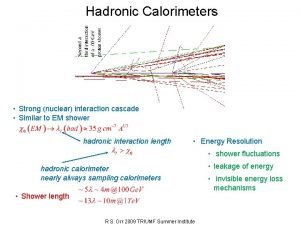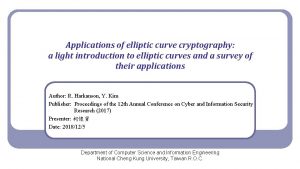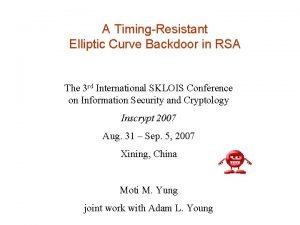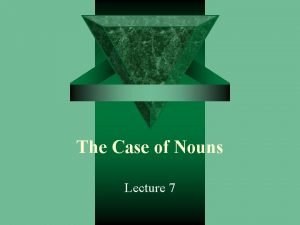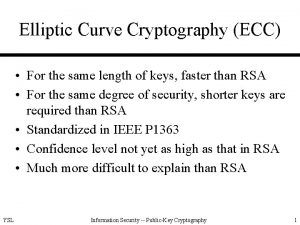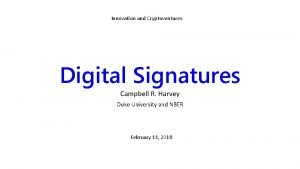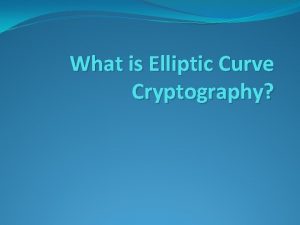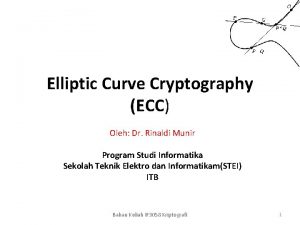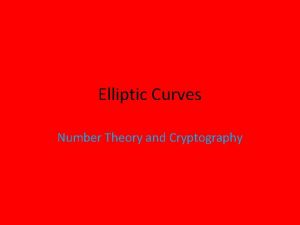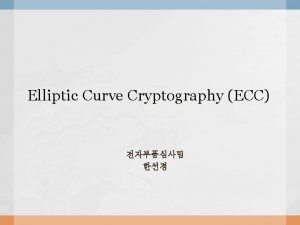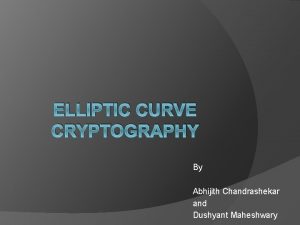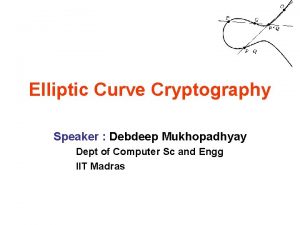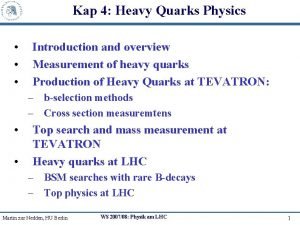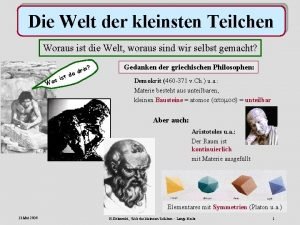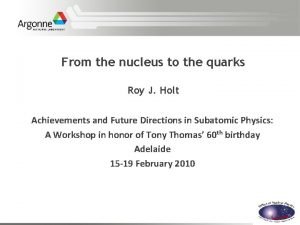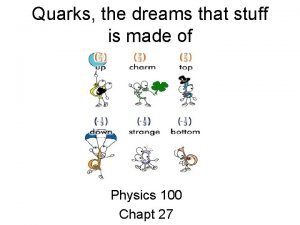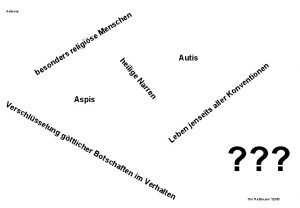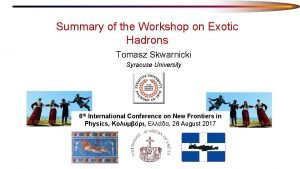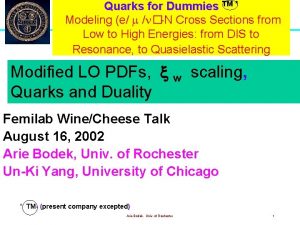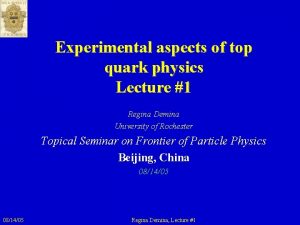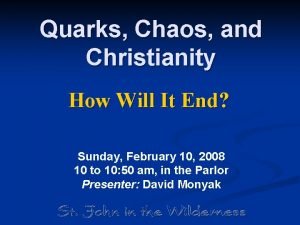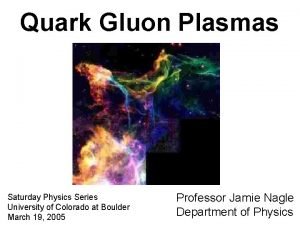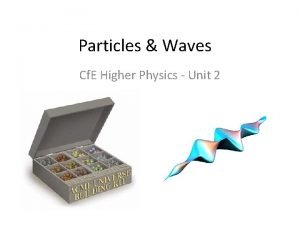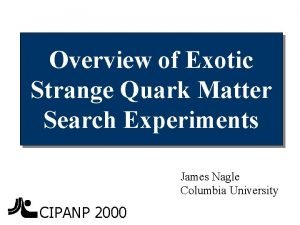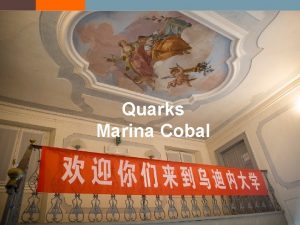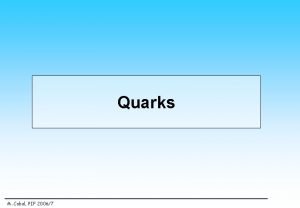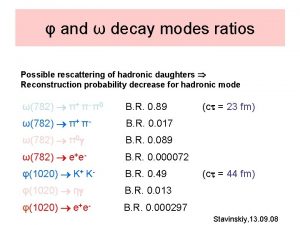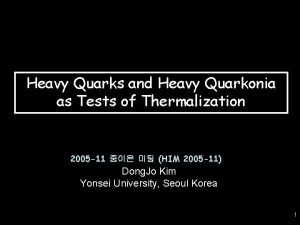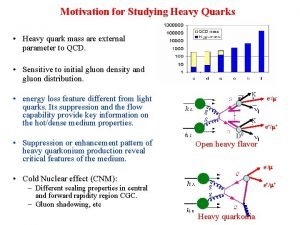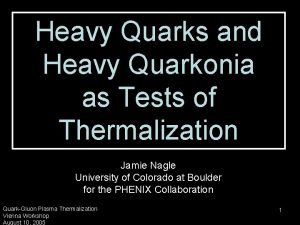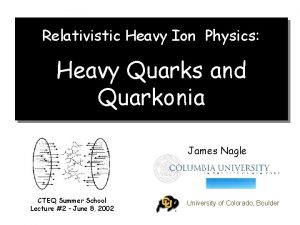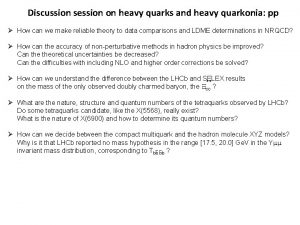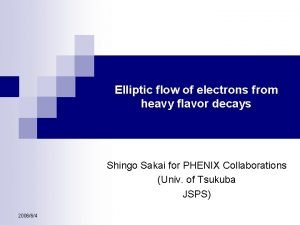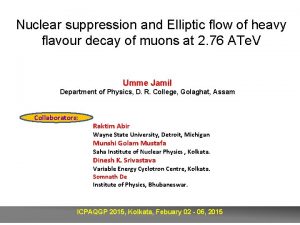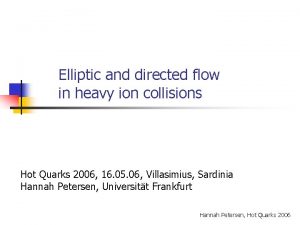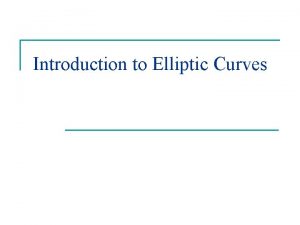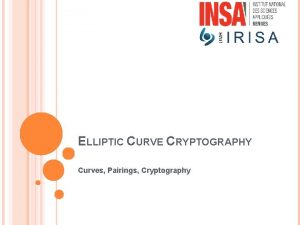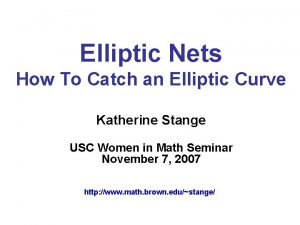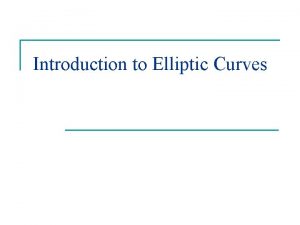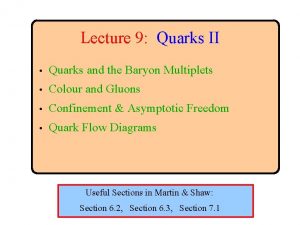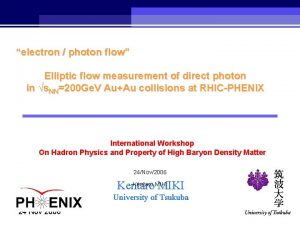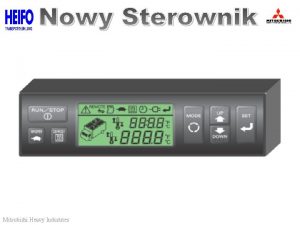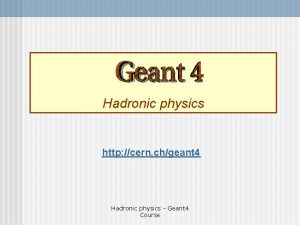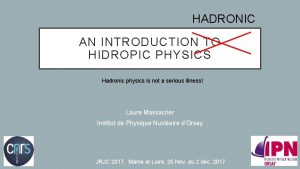Hadronic rescattering in elliptic flow Heavy quarks at





































- Slides: 37

Hadronic rescattering in elliptic flow & Heavy quarks at RHIC Yongseok Oh Kyungpook National University Heavy Ion Meeting 2011 -02, Muju Resort Feb. 27 -Mar. 1, 2011

Contents � � Introduction Hadronic rescattering in elliptic flow u Deuteron elliptic flow - � Coalescence mode Dynamical model Transport model Heavy quarks in RHIC u u Baryon to meson ratio Nuclear modification factor of non-photonic electrons P. 2 2/27/20113/1/2011

1. Introduction � Relativistic heavy ion collision � QGP: a new state of matter � s. QGP (strongly interacting QGP) 3 2/27/20113/1/2011

Relativistic Heavy Ion Collisions P. 4 2/27/20113/1/2011

RHIC QGP Expansion Hadronization Freeze-out Hadron rescattering detector l Test of hadron models - Large multiplicity - Find the physical quantities that are sensitive to hadron models l QGP signals - Hadron rescattering effects P. 5 2/27/20113/1/2011

s. QGP q Observed state in relativistic heavy ion collisions @ RHIC � � Perfect fluid behavior (hydrodynamics) Strong collective behavior (large elliptic flow) à q Strong coupling nature of Quark-Gluon Plasma New lattice results q q bound state could survive at T > Tc Even at T > Tc, the interaction is still strong g q Possible existence of quasi bound states of quarks and gluons such as qq, gg Shuryak and Zahed, PRC Diquarks in hadron physics q 70 Existence of a diquark in baryons? Lichtenberg, Anselmino, Wilczek & others P. 6 2/27/20113/1/2011

HADRON RESCATTERING IN ELLIPTIC FLOW P. 7 2/27/20113/1/2011

Elliptic Flow � Elliptic flow : a measure of the strength of the second Fourier coefficient in the azimuthal angle distribution of particle transverse momentum relative to the reaction plane a azimuthal anisotropy of the momentum distribution of particles Elliptic Flow v 2: momentum anisotropy ⇒ RHIC data show large momentum anisotropy P. 8 2/27/20113/1/2011

Elliptic flow � information on the properties of the hot dense matter formed during the initial stage of RHIC � � Mass ordering: v 2 decreases with increasing hadron mass Constituent quark number scaling Quark number scaling (quark recombination) Mass ordering (hydrodynamics) Fisher-Tippet (Gumbel) distr. P. 9 Negative v 2 for heavy mass? EKT or p. T scaling 2/27/20113/1/2011

Elliptic flow � Negative elliptic flow at small p. T for heavy particles? � deuteron (~1. 9 Ge. V) � J/y (~3 Ge. V) P. 10 2/27/20113/1/2011

Elliptic flow (scaling) � � Coalescence model For J/y � � � For deuteron � � � charm quark + charm anti-quark v 2 of the charm quark: negative at small p. T? proton + neutron v 2 of the nucleon: positive (by experiments) Intriguing questions on the mechanism of particle production and their interactions P. 11 2/27/20113/1/2011

2. Deuteron elliptic flow � Coalescence model (the simplest version) � � The deuteron yield in momentum space is proportional to the product of the proton and neutron densities at half the momentum of produced deuteron The deuteron elliptic flow would satisfy exactly the nucleon number scaling and thus the quark number scaling as well. P. 12 2/27/20113/1/2011

Elliptic flow: blast-wave model � Blast-wave model � In cylindrical coordinates � Transverse flow velocity P. 13 2/27/20113/1/2011

� Test of a simple blast-wave model � Transverse flow velocity Fitted results Requires different parameter sets! Fitted for mesons P. 14 Fitted for baryons 2/27/20113/1/2011

Modified coalescence model � Take into account the momentum spread of the deuteron wave function Hulthen WF � � Gives small deviation from the exact quark number scaling Does not satisfy energy conservation. � Effects of energy conservation? P. 15 2/27/20113/1/2011

Dynamical model � Use dynamical processes for deuteron production � � Dominant deuteron production reaction: two-body scattering Only the rate can be calculated. No a priori restriction such as � Energy is conserved as well as momentum 3 -body reactions can be added such as P. 16 2/27/20113/1/2011

Dynamical model � Inputs (Nucleon spectrum) P. 17 2/27/20113/1/2011

Dynamical model � Inputs (pion) P. 18 2/27/20113/1/2011

Dynamical model � Input for the production amplitude of Adjusted to fit the data P. 19 2/27/20113/1/2011

Dynamical model � Results Oh and Ko, PRC 76 Negative v 2 P. 20 2/27/20113/1/2011

Dynamical model � Results � Deuteron spectrum ¦ � Radial flow effect is not fully taken into account Deuteron elliptic flow ¦ ¦ ¦ Consistent with the PHENIX data Cannot explain the negative v 2 of preliminary STAR data Support coalescence model at medium p. T Momentum conservation has more important role in this region. Holds also for low momentum region? P. 21 2/27/20113/1/2011

Dynamical model vs Coalescence model � � In coalescence model, pd/2=p 1=p 2 In dynamical model, energy-momentum conservation determines the physical region Allowed by the coalescence model P. 22 2/27/20113/1/2011

Dynamical model vs Coalescence model � At low p. T region � � The momenta chosen by the coalescence model is not physically allowed region. So, the similarities between the dynamical model and coalescence model are accidental, ¦ If v 2 of the nucleon at low p. T is negative ¢ Coalescence model gives negative deuteron v 2 ¢ Dynamical model gives positive deuteron v 2 P. 23 2/27/20113/1/2011

Transport model Assume that initial hadrons formed by the QGP are thermalized. (blast-wave model) ⇒ and, then, hadronic rescattering P. 24 Initial state Hadron rescatterings/collective expansion via ART 2/27/20113/1/2011

Transport model � Transport model ART (A Relativistic Transport model) � � includes mesons (p, r, w, h, K, K*, f) and baryons (N, D, L, S and their anti-particles) In this work, we include the interactions with the deuteron P. 25 2/27/20113/1/2011

Transport model � Inputs � The parameters for the initial state are determined to reproduce the measured pion/nucleon data Large rescattering effects in the elliptic flow P. 26 2/27/20113/1/2011

Transport model � Oh et al. , PRC 80 Output � Deuteron spectrum p. T spectrum and elliptic flow P. 27 2/27/20113/1/2011

Transport model Deviation from the scaling behavior P. 28 2/27/20113/1/2011

Outlook QGP Expansion Hadronization For more complete simulation of RHIC Modify Quark recombination Freeze-out Hadron rescattering Measurements Modify hadronic rescattering Use improved hadron models: structure & interactions P. 29 2/27/20113/1/2011

HEAVY QUARKS IN RHIC P. 30 2/27/20113/1/2011

Hadron models @ RHIC Test of diquark model for baryons at RHIC S. H. Lee et al. , PRL 100 (2008) Sateesh, PRD 45 (1992) Wilczek Three-quark model Diquark model The most attractive diquark channel: scalar diqaurk How to distinguish diquark model from the three-quark model : diquark + heavy-quark or three-quark : three-quark c use the production of and in relativistic heavy ion collisions ratio will be enhanced by a factor of 4 -8: S. H. Lee et al. , PRL 100 (2008) ratio will be enhanced by a factor of 80: Sateesh, PRD 45 (1992) P. 31 2/27/20113/1/2011

pp & AA collisions � PYTHIA model (pp) Oh et al. , PRC 79, 044905 067902 Mostly due to D* decay: D*0 g D+pis prohibited by energy conservation � Thermal model (AA) P. 32 2/27/20113/1/2011

Thermal model (AA) � Role of resonance decays Cf. In bottom sector, the B* meson cannot decay into the B meson. P. 33 2/27/20113/1/2011

Coalescence model (AA) � Coalescence model � � � Production of a particle is proportional to the overlap integral of the wave functions of the constituents (parameters: fitted by the rms radii of the particles) Thermal distributions for light quarks and diquarks Heavy quark distributions: from p. QCD P. 34 2/27/20113/1/2011

Results: Coalescence model (AA) � Larger than thermal model predictions Results Three-quark model ~1. 6 times diquark model Meson/baryon ratio P. 35 2/27/20113/1/2011

Nuclear modification factor � Non-photonic electron RAA P. 36 2/27/20113/1/2011

Nuclear modification factor � Non-photonic electron RAA P. 37 2/27/20113/1/2011
 Hadronic
Hadronic Hadronic cascade
Hadronic cascade Top heavy bottom heavy asymptotes
Top heavy bottom heavy asymptotes Elliptic curve cryptography applications
Elliptic curve cryptography applications Elliptic curve cryptography backdoor
Elliptic curve cryptography backdoor Elliptic genitive
Elliptic genitive Cryptography
Cryptography Elliptic curve cryptography
Elliptic curve cryptography Ecdlp
Ecdlp Elliptic curve discrete logarithm problem
Elliptic curve discrete logarithm problem Elliptic curves number theory and cryptography
Elliptic curves number theory and cryptography Lieberman
Lieberman Elliptic curve cryptography
Elliptic curve cryptography Elliptic curve
Elliptic curve Elliptic curve diffie hellman example
Elliptic curve diffie hellman example Quarks
Quarks Große stärke die man kleinsten teilchen entlockt
Große stärke die man kleinsten teilchen entlockt Quarks
Quarks 6 types of quarks
6 types of quarks Proton neutron quarks
Proton neutron quarks Quarks und co autismus selbsttest
Quarks und co autismus selbsttest Color quarks
Color quarks Quarks for dummies
Quarks for dummies Quarks regina
Quarks regina Quarks chaos and christianity
Quarks chaos and christianity Proton neutron quarks
Proton neutron quarks 6 types of quarks
6 types of quarks Quark matter
Quark matter Data flow vs control flow
Data flow vs control flow External flow
External flow T piece
T piece Data flow structure
Data flow structure Cheese processing flow chart
Cheese processing flow chart Ecological succession
Ecological succession Rotational or irrotational flow
Rotational or irrotational flow 3 liters fio2
3 liters fio2 Control flow and data flow computers
Control flow and data flow computers Flow of energy vs flow of matter
Flow of energy vs flow of matter

